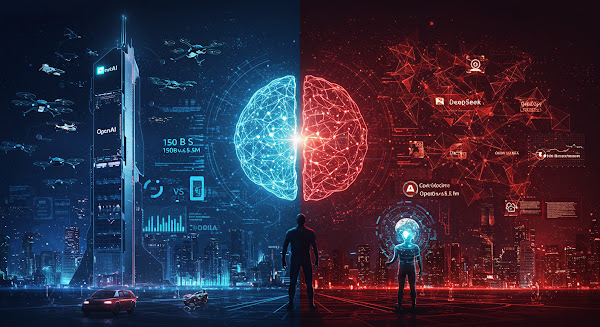If you’ve been following the AI space lately, you’ve probably heard about the jaw-dropping sums of money pouring into artificial intelligence. The U.S. is investing over $150 billion annually into proprietary AI systems developed by giants like OpenAI and Nvidia. Meanwhile, China is quietly rewriting the rulebook by training advanced models like DeepSeek R for as little as $5.5 million using open-source frameworks. This David-and-Goliath dynamic isn’t just fascinating—it’s reshaping the future of AI. Let’s unpack what this means for innovation, ethics, and global power struggles over the next five years.
The Battle of Strategies: Open Source vs. Proprietary Titans
To understand why this rivalry matters, let’s start with a quick comparison of the two approaches.
| Aspect | United States | China |
|---|---|---|
| Investment | $150B+/year on proprietary models and infrastructure | $5.5M to train models like DeepSeek R |
| Key Players | OpenAI, Google, Nvidia | DeepSeek, Baidu, Alibaba |
| Focus | Cutting-edge foundational research | Cost optimization and rapid scalability |
| Regulation | Emerging ethical guidelines | State-controlled AI applications |
| Global Influence | Dominates high-performance hardware | Expanding via open-source ecosystems |
The Rise of Open Source: How China Is Redefining Efficiency
How Does DeepSeek R1 Work?
At the heart of China’s cost-cutting success is DeepSeek R1, a reinforcement learning framework that slashes training expenses. Unlike traditional methods requiring thousands of expensive GPUs, DeepSeek R1 uses smarter data sampling and distributed computing to reduce hardware needs. Think of it as building a sports car with bicycle parts—it’s not just cheaper, but it forces innovators to rethink design principles.
Is DeepSeek Open Source?
Yes—and that’s the kicker. DeepSeek’s models are publicly available, enabling developers worldwide to tweak and improve them. This democratizes AI innovation but also raises questions: Can open-source models stay ethical? Who’s responsible if they’re misused? China’s government sees open-source as a way to expand its tech influence, but critics warn it could empower bad actors.
The Good, the Bad, and the Geopolitical
Positive Implications: Innovation Unleashed
- Democratizing AI Development: Small startups and researchers can now access tools once reserved for tech giants. A student in Nairobi or a startup in São Paulo can fine-tune DeepSeek R1 for local needs without begging for venture capital.
- Cost Pressures Drive Efficiency: Western firms are being forced to innovate. Nvidia recently slashed prices for its AI chips after Chinese labs proved similar results could be achieved with less.
- Collaborative Breakthroughs: Open-source ecosystems have accelerated progress in climate modeling and medical research. For example, DeepSeek’s algorithms are now used to predict extreme weather patterns in partnership with European labs.
Negative Implications: Risks and Power Plays
- The Ethics Dilemma: China’s AI is deeply integrated with state surveillance. Open-source models could spread these capabilities to authoritarian regimes.
- A Fragmented Internet: Imagine a world where the U.S. and China operate parallel AI ecosystems with incompatible standards—think “AI Iron Curtain.”
- Job Market Shakeups: Cheap, scalable AI could automate industries faster than societies can adapt. A McKinsey study estimates 30% of global jobs could be AI-driven by 2030, with blue-collar and creative roles at risk.
- Security Threats: Low-cost AI tools make it easier to launch cyberattacks or deepfake disinformation campaigns.
DeepSeek R1 vs. OpenAI O1: What the Models Tell Us
Let’s zoom in on two flagship models:
- OpenAI O1: The latest iteration of GPT-4, costing ~$100 million to train. It’s a closed system, optimized for high accuracy in tasks like legal analysis and coding.
- DeepSeek R1: An open-source model trained for $6.5 million, designed for scalability and adaptability. It’s less polished but highly customizable.
| Metric | OpenAI O1 | DeepSeek R1 |
|---|---|---|
| Training Cost | $100M+ | $5.5M |
| Access | Proprietary, paid API | Open-source, free for research |
| Strengths | Precision, enterprise support | Flexibility, low-cost scaling |
| Weaknesses | High barrier to entry | Less polished for niche tasks |
What’s Next? 5 Predictions for the AI Landscape (2025-2030)
- Hybrid Models Will Dominate: Companies like Microsoft are already blending proprietary and open-source AI. The future belongs to those who can do both.
- Regulatory Wars Escalate: The EU’s AI Act and U.S. Executive Order 14110 will clash with China’s state-driven model, complicating global collaboration.
- AI Nationalism Rises: Countries will hoard data and talent, mirroring today’s semiconductor battles.
- The $10 Million Model: Training costs will keep falling, enabling startups to challenge incumbents.
- Ethical AI Becomes a Selling Point: Consumers will favor transparent, auditable systems—pressure that could force China to soften its stance.
Conclusion: Collaboration or Cold War?
The U.S. and China are running two very different races. America is sprinting toward superintelligent AI fueled by private capital, while China is running a marathon with open-source tools and state backing. Both have strengths, but the real winner will be the side that balances innovation with responsibility.
As DeepSeek co-founder Li Zhang recently told The Conversation, “AI isn’t a zero-sum game. The next breakthrough could come from a garage in Kansas or a lab in Shenzhen.” Whether that’s true depends on how we navigate the next five years: Will we weaponize AI, or wield it as a shared tool for progress?
What’s your take? Drop a comment below—let’s keep the conversation open.
